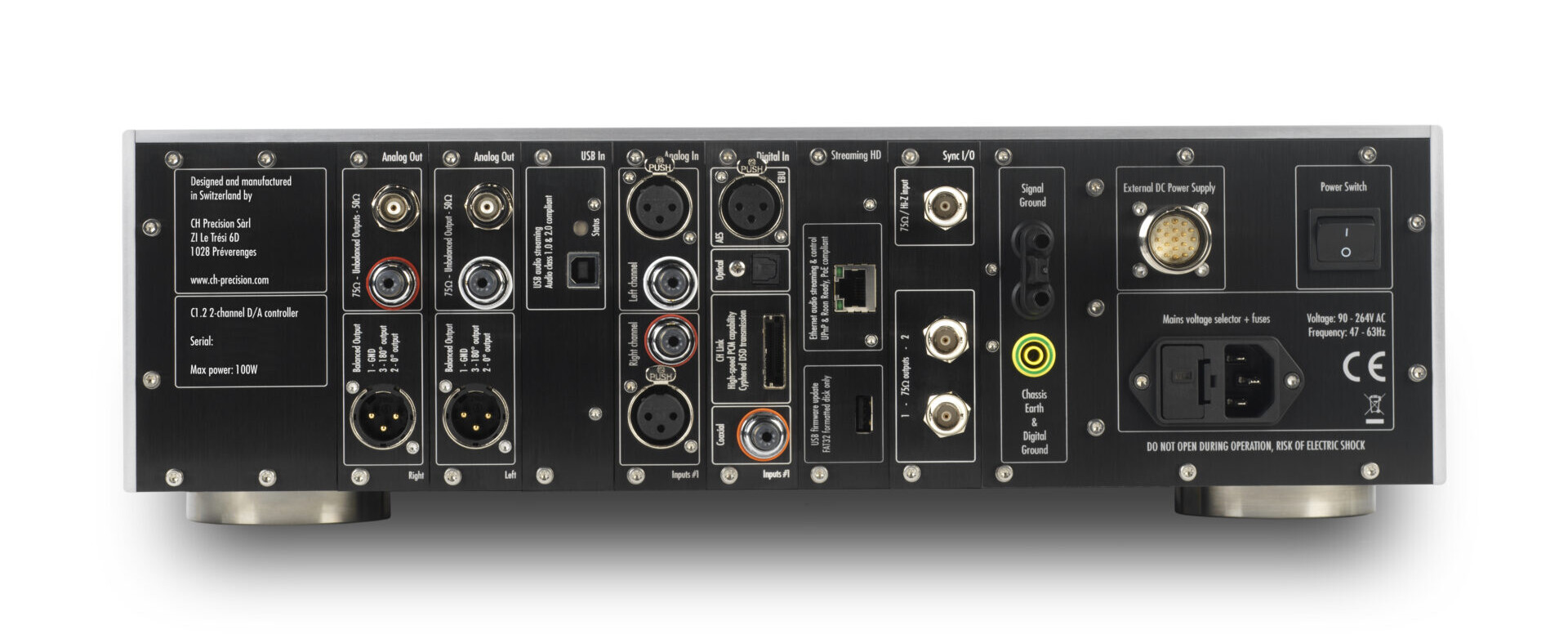The C1.2 is large and heavy for a DAC. A full 440mm wide, the substantial chassis occupies a square footprint and stands 132mm tall on its shallow feet. That’s a lot of internal space and it’s heavily populated. The chassis itself is an elegant and beautifully engineered, aluminium plate-to-plate construction, entirely free of visible fixings. The four screw-on caps, flush-mounted in each corner of the top-plate give access to threaded shafts. Composite, spiked posts (hardened aluminium tips combined with Delrin poles) dropped into those shafts allow the unit to be precisely levelled and also mechanically couple the massive base-plate to the supporting surface.

The front-panel is dominated by the large, full-colour display, the familiar CH dual-concentric control on the right, visually balanced by the curved feature-line on the left. Apart from the stand-by LED in the logo positioned top left, that’s all you see. The business end is round the back, a rear panel that is literally crammed with inputs, outputs and connections. Let’s start by looking at the base model C1.2 ($36,000). Running left to right across the rear panel, the layout reads like this:
A pair of dual-mono analogue output cards (each offering balanced XLR, RCA and 50Ω BNC connections).
Two blank slots for optional input cards.
One Digital-In HD card (CH-Link HD, AES/EBU, S/PDIF and TosLink inputs)
One Ethernet-In HD card (with USB A socket for firmware upgrades only)
Another blank slot, dedicated to the optional Clock Sync card
The AC input and unit grounding panel. As well as the IEC input, this panel carries a multi-pin connector for attaching the optional X1 external power supply. As with all compatible CH components, the X1 delivers a further, substantial upgrade in performance, although I’m not going to dwell on that here. The vertical row of three 4mm sockets (and jumper) allows users to separate or tie together the chassis and signal grounds, optimising grounding arrangements. Like the mechanical grounding feature, this arrangement is common to all the CH 1 Series components, but given that the C1.2 is both a digital unit and a potential system controller, it’s a particularly crucial facility here.
Ch, ch, ch, changes
The next stage is to consider the optional inputs. The Sync I/O card allows the C1.2 to be integrated into a central clocking arrangement, either with an external clock (such as the CH T1 Time Reference) or simply with a designated Master clock within the existing units. It offers one input and two outputs on BNC connectors.
The input options are more complex. The two option slots can accommodate one or more of the following input cards, in any combination:
The Digital-In HD card
The Analog-In card (one pair of balanced XLR, one pair of single-ended RCA)
The USB-In card (one USB-B input)
These optional slots allow the user to add additional inputs to suit their system requirements, be those analogue or digital. The inclusion of an analogue input option is extremely unusual, but it allows the use of the C1.2 as a controller or pre-amp in a multi-format system scenario, with both analogue and digital sources.
Opportunity knocks…
The second set of options involves the expansion (as opposed to the configuration) of the C1.2. I’ve already mentioned the possibility of adding the X1 external power supply. As with other CH components, the C1.2 can be upgraded from dual-monaural (two separate channels in a single box) to true monaural, where each channel gets its own box. In practice, the C1.2 Mono is actually a three-box product (!) a single head unit being used to accept and distribute digital signals to separate left and right channel DACs. That in turn creates the opportunity to add extra X1s – as many as three in all. In addition, there’s also the aforementioned T1 Time Reference Master Clock and the option to add a D1.5 CD/SACD transport, connected via the CH-Link HD input – and naturally with the option to add yet another X1. Tot that lot up and you end up with a nine-box digital front-end!

